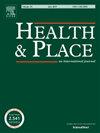少女和公共场所的体育活动:来自安特卫普市的见解
IF 4.1
2区 医学
Q1 PUBLIC, ENVIRONMENTAL & OCCUPATIONAL HEALTH
引用次数: 0
摘要
青少年时期的体育活动是长期健康的一个关键决定因素,然而,十几岁的女孩始终不如男孩活跃。城市公共空间在促进从非正式游戏到有组织的体育活动的日常机会方面发挥着核心作用。然而,这些空间并不是对所有人开放的。在这些地方,性别等级和规范浮出水面,但也有其他交叉的不平等结构——如社会经济背景、移民身份、残疾/能力和宗教——决定了谁有资格参与,谁没有资格参与。本研究探讨了不同因素如何交叉影响安特卫普-北和博尔格豪特城市地区少女参加体育活动的情况。基于对政策制定者、青年工作者和当地组织的32次访谈,我们应用适应性社会生态框架来分析个人、社会文化、建筑环境和政策维度的相互作用。研究结果表明,诸如减少对青年服务的投资等政治选择如何限制了参与活动的机会,而建筑环境中缺乏包容性设计则加剧了这些不平等。在社会文化层面,性别刻板印象塑造了人们对谁属于公共空间的期望,这反过来又助长了青春期女孩对个人身体形象的关注。这些相互交织的障碍表明,体育活动机会不仅受到个人因素的影响,还受到城市结构中系统性排斥形式的影响。为解决这一问题,需要采取包容性政策和参与性城市规划方法,创造积极支持女孩参与体育活动及其健康和福祉的公共空间。本文章由计算机程序翻译,如有差异,请以英文原文为准。
Adolescent girls and physical activity in public spaces: insights from the city of Antwerp
Physical activity in adolescence is a key determinant of long-term health, yet teenage girls remain consistently less active than boys. Urban public spaces play a central role in facilitating everyday opportunities for physical activity, from informal play to organised sport. However, these spaces are not equally accessible or welcoming to all. They are sites where gendered hierarchies and norms surface, but also where other intersecting structures of inequality — such as socioeconomic background, migration status, dis/ability, and religion — shape who feels entitled to participate and who does not. This study explores how different factors intersect to influence teenage girls' participation in physical activity in the urban areas of Antwerpen-Noord and Borgerhout. Based on 32 interviews with policymakers, youth workers, and local organisations, we apply an adapted socio-ecological framework to analyse the interplay of individual, sociocultural, built environment, and policy dimensions. The findings show how political choices such as disinvestment in youth services limit access to activities, while the absence of inclusive design in the built environment reinforce these inequalities. At the sociocultural level, gender stereotypes shape expectations about who belongs in public space, which in turn feeds into individual-level concerns about body image amongst adolescent girls. These intersecting barriers show how physical activity opportunities are mediated not only by individual factors but by systemic forms of exclusion embedded in the urban fabric. To counter this, inclusive policies and participatory approaches to urban planning are needed to create public spaces that actively support girls’ engagement in physical activity and their health and wellbeing.
求助全文
通过发布文献求助,成功后即可免费获取论文全文。
去求助
来源期刊

Health & Place
PUBLIC, ENVIRONMENTAL & OCCUPATIONAL HEALTH-
CiteScore
7.70
自引率
6.20%
发文量
176
审稿时长
29 days
期刊介绍:
he journal is an interdisciplinary journal dedicated to the study of all aspects of health and health care in which place or location matters.
 求助内容:
求助内容: 应助结果提醒方式:
应助结果提醒方式:


